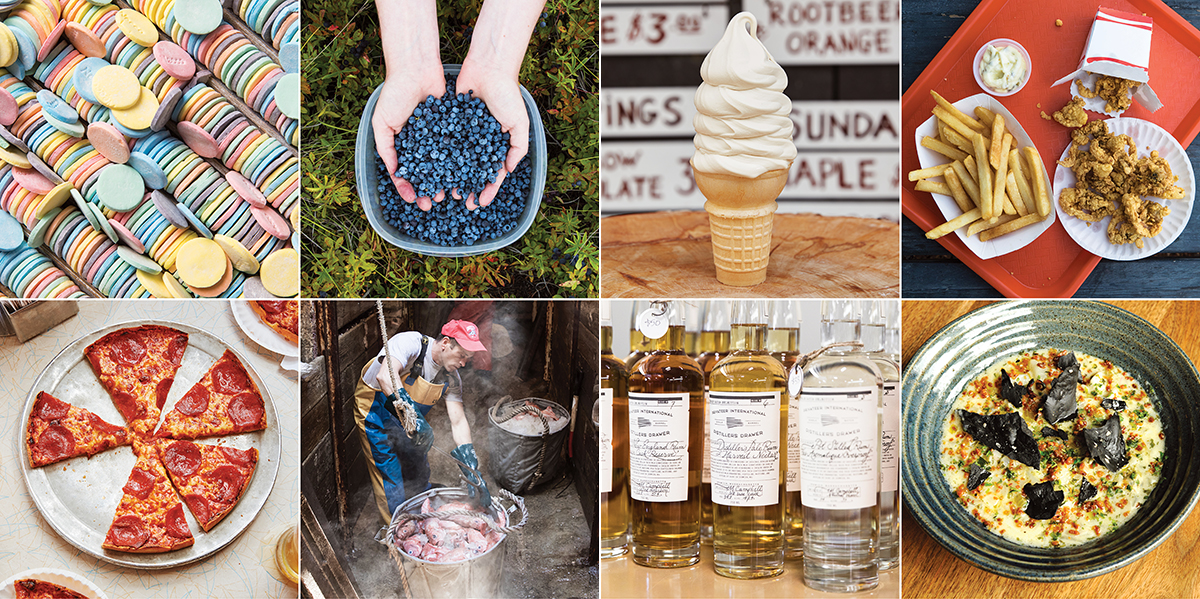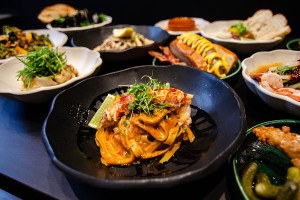What Does It Mean to Eat Like a New Englander in 2017?

Photographs by Greta Rybus (wafers, blueberries, fish, rum); Jim Brueckner (pizza, creemee, clam strips); Julia Hopkins (chowder)
I began this project with a simple question: What does it mean to eat like a New Englander in 2017?
As someone who has been tearing into lobsters and steamers since my highchair days, the last place I expected it to culminate was in a 24-hour restaurant in Cambridge with a paper cup of grits—a dish I’ve long associated with southern cuisine.
The Pilgrims sent me there. Okay, the next best thing: It was a food expert from Plimoth Plantation, where a few weeks earlier I watched a miller pack up bags of cornmeal—ground on the living history museum’s working mill—to send to the fast-casual chainlet Clover.
As anyone who’s heard the story of Squanto knows, corn was the most important food in New England for the Colonists—and for the Native Americans for centuries before they arrived. “It’s what ties the two diets together,” says Plimoth Plantation culinarian Kathleen Wall. She describes cornmeal-based Indian pudding as the quintessential New England dish.
So it actually makes perfect sense that cornmeal grits are on the menu at Clover, where the clerk who took my order on a handheld device earnestly recited the restaurant’s ethos: “We’re all about being as fresh, local, and sustainable as possible.” This is the techy locavore’s version of what it means to eat like a New Englander.
But it isn’t everyone’s. About a mile away, at Loyal Nine, chef and history nerd Marc Sheehan’s interpretation includes staying true to the sort of food made here from the Colonial era through the 1840s: soused bluefish on brown bread; mussels with pease pudding. “The second you put cilantro or gochujang or soy sauce on a dish, it’s not what we’re doing,” Sheehan says.
Despite being a 13th-generation Mayflower descendant, meanwhile, Puritan & Company chef Will Gilson says eating like a local not only includes historical recipes and farm-fresh vegetables, but also regional foods such as bar pizza and roast beef sandwiches. And there are other viewpoints. For Dartmouth farmer Eva Sommaripa, who supplies produce to Whole Foods and several Boston-area restaurants, it means being a responsible steward of the land and not wasting a damn thing. When I first met her a few years ago, I marveled over how she collected the tiny green sprouts inside garlic cloves until she had saved enough to make a bitter pesto.
That reminds me of the scrappiness I often find myself chuckling over when I visit my father in Rhode Island. For him, eating like a native means hunting down the freshest, cheapest littlenecks he can find—probably down a shell-lined driveway, off the back of some clammer’s pickup truck—and then heading home to perfect his own version of the state’s signature hot wiener sauce.
Of course, there are many other culinary customs that root us here, from tree tapping and apple picking to venison hunting. And it’s also true that for some, eating like a New Englander is limited to a daily coffee break at Dunks and a few orders of fried clams each summer. Because the thing is, the single, neat definition I started off seeking doesn’t exist. What does exist is a patchwork of traditions, tastes, and experiences, new and old, that are anything but stodgy.


